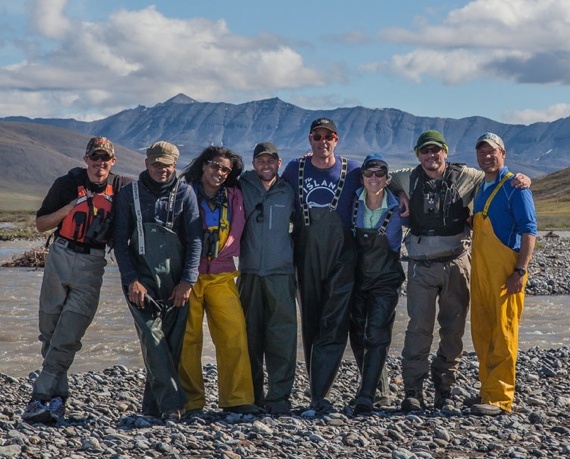I returned from the Arctic last week, and the beauty and peacefulness that I experienced there still occupy my dreams. Sure, the grizzly we encountered in our camp the first night has a starring role, but mostly it's the grandeur and sublime tranquility that were so captivating.
I knew the Arctic National Wildlife Refuge was big, but I didn't really comprehend how big until we flew into it. For miles and miles and miles on end, we passed over one mountain, broad valley, and watershed after another. Such an expanse of untouched wilderness was inspiring, humbling, and breathtaking all at once.

Could there be any better way to celebrate the 50th anniversary of the Wilderness Act than to explore (in my case, for the first time) the most completely wild place in the United States? If you want to be as far as possible from any human trail, road, or settlement, then this is where you come. The Arctic National Wildlife Refuge encompasses more than 19.6 million acres, of which eight million are designated as a federally protected wilderness area.
It's not called a wildlife refuge for nothing, either. This is as north as North America gets, but animals ranging from shrews to grizzlies call it home, along with more than 160,000 free-roaming caribou. Every year, the Porcupine caribou migrate 1,500 miles to their calving grounds on the coastal plain by the Arctic Ocean. That's like walking from Boston to Miami. It may be the greatest wildlife spectacle in North America.
I wondered whether we would see the Porcupine herd, but not for long -- there must have been a thousand caribou in the grassy valley where our plane set us down. After exploring in the valley under the midnight sun, we spent the rest of the week rafting down the Aichilik River to the coastal plain, winding up at the shore of the Arctic Ocean.
What a trip. Along the way, we saw wilderness at its wildest, with the Brooks Range looming at our backs and golden eagles, tundra swans, long-tailed jaegers, and even snowy owls watching from above. Just like the caribou, though, we were making another kind of journey -- from the part of the Refuge that is safe from oil and gas drilling to the part that is not.
The coastal plain of the Refuge, where the caribou give birth to their calves each year, has an odd name: Area 10-02. When the Arctic National Wildlife Refuge was expanded in 1980 as part of the Alaska National Interest Lands Conservation Act, proponents of oil and gas drilling insisted on adding a section (10-02) to the bill that mandated an inventory of potential oil and gas resources. How much oil is there? No one can say for sure, other than that it's not enough to affect global market prices. Undoubtedly, it would have a devastating effect on the caribou and other wildlife.
It would be easy to lose count of how many times during the past four decades we've come close to losing the fight to keep oil companies from invading the coastal plain. It's been a near thing way too many times. Yet we've always managed to keep the drills at bay -- and by "we," I mean the millions of Americans who've signed petitions, contacted their representatives, and otherwise played a part in, first, creating the Arctic National Wildlife Refuge and then in making sure that the oil companies stayed out.
That, above all, is what kept going through my mind as I marveled at this wilderness. Just look at what we did, together! Somehow, we've kept all of this safe. We all should be proud of that.
When at last we reached the shore of the Arctic Ocean, we had another surprise. We'd hoped we might be able to venture onto the frozen sea and perhaps climb an ice ridge. Instead, waves lapped at the shore, with only a few isolated small icebergs offshore -- a reminder that the climate in Alaska is warming more rapidly than anywhere else in North America. A decade ago, the sea ice would definitely have extended all the way to the shore.
(One more reason to be in New York on September 21 for the People's Climate March.)
Our visit to the Arctic National Wildlife Refuge ended at the Inupiat village of Kaktovik (pop. 293). None of the local people I talked to were in favor of drilling, either offshore or on the coastal plain. Their main concern was to ensure they would continue to be able to do subsistence hunting to provide for themselves. None of them wanted the oil industry to move into the Refuge.
If that ever were to happen, we don't have to wonder what it would look like. West of the Arctic National Wildlife Refuge lies the largest oil field in North America -- a sprawling complex of oil wells, gravel roads, air strips, gravel pads, and equipment-storage sites that covers an area the size of Rhode Island. And as usual, where there is oil, there are oil spills. The largest was in 2006, when a corroded BP pipeline ruptured and leaked about 267,000 gallons of oil.
Could that happen in the Arctic National Wildlife Refuge? Yes, as long as there's still money to be made from selling oil, and as long as the status of the coastal plain remains in limbo. The current U.S. House of Representatives would happily turn the coastal plain into a Chevron parking lot -- as long as oil companies could still erect their drilling rigs.
We can never let that happen. So until the coastal plain is truly protected once and for all, we all need to keep up the fight. Join the millions who've helped keep this wilderness wild: Ask the Obama administration to do everything it can to establish a lasting legacy by protecting the coastal plain of the Arctic National Wildlife Refuge.